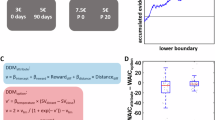Abstract
THE reactions of animals to situations that suddenly become more attractive or less attractive have long seemed potentially useful for the evaluation of drugs and other treatments assumed to affect emotional responsivity1. Crespi2,3 reported that rats shifted to a larger (or smaller) amount of reward ran faster (or slower) to the goal in a runway than control rats who were accustomed to the larger (or smaller) amount. But it has usually been difficult to find reliable overshooting or “positive contrast” effects to an increase in reward magnitude, and even the more reliable negative contrast effect (undershooting to a decrease in reward magnitude) has proved troublesome when separate experimental and control groups are used4. Furthermore, the transient character of the effects, even when obtained, makes them inconvenient for the chronic testing of various treatments, such as antidepressant drugs or brain lesions. Finally, recent demonstrations of “behavioural contrast” have depended on somewhat complex multiple schedule situations, not necessarily related to that originally used by Crespi5–7. Here we report a simple technique for the repeated study of both positive and negative effects in the same animals, with results that are stable over weeks of daily testing.
This is a preview of subscription content, access via your institution
Access options
Subscribe to this journal
Receive 51 print issues and online access
$199.00 per year
only $3.90 per issue
Buy this article
- Purchase on SpringerLink
- Instant access to full article PDF
Prices may be subject to local taxes which are calculated during checkout
Similar content being viewed by others
References
Weiskrantz, L., in Analysis of Behavioral Change (edit. by Weiskrantz, L.) (Harper and Row, New York, 1968).
Crespi, L. P., Amer. J. Psychol., 55, 467 (1942).
Crespi, L. P., Psychol. Rev., 51, 341 (1944).
Dunham, P. J., Psychol. Bull., 69, 295 (1968).
Reynolds, G. S., J. Exp. Anal. Behav., 4, 57 (1961).
Catania, A. C., in Operant Behavior (edit. by Honig, W. K.) (Appleton-Century-Crofts, New York, 1966).
Terrace, H. S., J. Exp. Anal. Behav., 9, 613 (1966).
Spence, K. W., Behavior Theory and Conditioning (Yale University Press, New Haven, 1956).
Shanab, M. E., Sanders, R., and Premack, D., Science, 164, 724 (1969).
Author information
Authors and Affiliations
Rights and permissions
About this article
Cite this article
BALTZER, V., WEISKRANTZ, L. Negative and Positive Behavioural Contrast in the Same Animals. Nature 228, 581–582 (1970). https://doi.org/10.1038/228581a0
Received:
Issue date:
DOI: https://doi.org/10.1038/228581a0
This article is cited by
-
A reappraisal of successive negative contrast in two populations of domestic dogs
Animal Cognition (2016)
-
Conditions under which chlordiazepoxide influences gustatory contrast
Psychopharmacology (1980)
-
Influence of amylobarbitone on operant depression and elation effects in the rat
Psychopharmacologia (1973)



